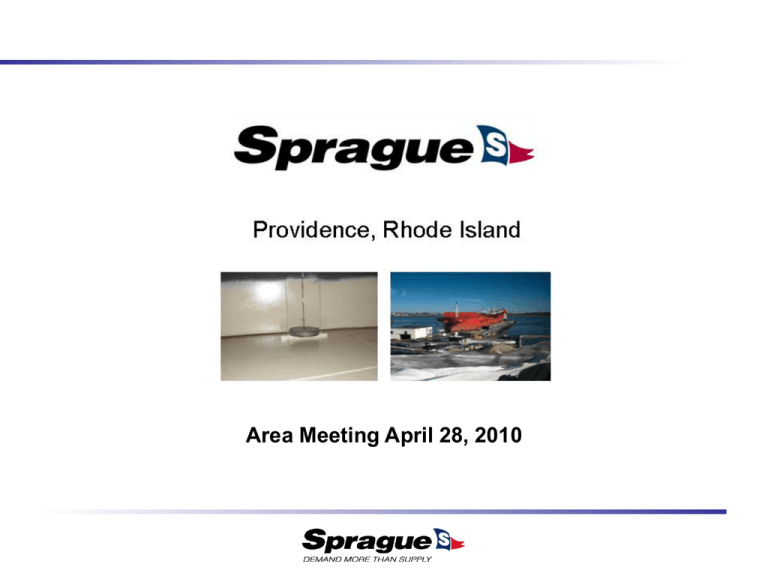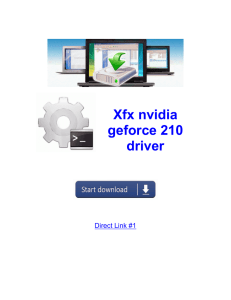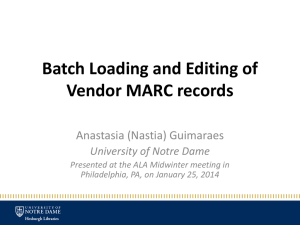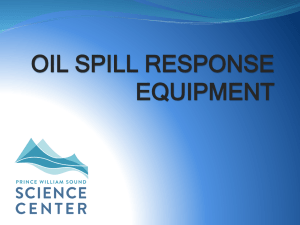PPT - RRT
advertisement

Area Meeting April 28, 2010 Sprague Spill Response and Prevention Overview • Sprague Providence Summary • Spill Response – Terminal Personnel • Loading Rack Policy and Driver Training • Driver Spill Response • Spill Response Equipment • Response Strategies • Monthly Terminal Inspections Sprague Providence Summary • 12 full time employees, 1 newly hired part time employee (operations) • 600,000 barrels of liquid storage • Products: – 2 oil – Diesel fuel (ultra low sulfur) – Residual fuel (#4 oil and #6 oil) – Road Salt – storage for 100,000 tons – Roof Asphalt – 125,000 barrels storage Terminal Spill Response Immediate Actions Upon Detecting an Oil Spill (excerpt from ERAP) • • • • • • • IMMEDIATE ACTIONS UPON DETECTING AN OIL SPILL All oil-handling personnel (initial responders) are trained to respond to an oil spill event in accordance with the procedure below. The “Immediate Actions” procedure provided below ensures that the initial spill responder is initiating the appropriate response actions at the earliest time possible, while waiting for the Terminal’s trained QI/AQI to arrive and assume control of the response strategy. 1. SAFETY. The safety of you and your co-workers is the top priority of any spill response effort. If you are unable to safely respond to a spill, clear the area. 2. NOTIFY OTHER TERMINAL PERSONNEL. Notify other on-site personnel of incident by way of handheld radios, internal communication systems, or internal alarms systems. 3. CONTAIN THE SOURCE. If upon assessing the situation you can safely contain the source, shutdown the operations, or prevent the spill from traveling offsite, do so. Otherwise, clear the area and wait for additional help. 4. SECURE THE AREA. Establish a safe perimeter around the spill to prevent personnel, equipment, trucks, etc., from unnecessarily entering the spill area. Ensure there are no ignition sources in the immediate area. 5. COLLECT PRELIMINARY SPILL INFORMATION. Perform a preliminary hazard assessment of the event using the Preliminary Spill Information Data Sheet. Data to include: • • • • • • • • • • Safety assessment; Type of product spilled; Approximate amount spilled; General location of spill; If product is in the water; and Initial response actions taken. 6. INITIATE ICS-201 FORM. Begin to document the sequence of events (actions taken and time) as they are performed using the ICS-201 Form. 7. INITIATE SPILL EMERGENCY NOTIFICATION PHONE LIST. 8. UTILIZE SPILL EQUIPMENT. Mobilize and deploy the appropriate spill response equipment at the terminal as necessary to respond to the spill. Contact contracted OSROs as necessary for additional spill response equipment, personnel, and temporary storage. 9. CONDUCT SAFETY ASSESSMENT. Assess and identify the potential hazards associated with the spill. Ensure all Sprague employees, initial responders, and outside contractors are informed of the spill hazards using the Site Health and Safety Plan. Preliminary Spill Information data sheet Abbreviated Emergency Notification List Abbreviated Emergency Notification List (continued) ICS 201 Form Instructions ICS 201 Form Instructions (continued) ICS 201 Form ICS 201 Form (continued) ICS 201 Form (continued) Loading Rack Policy and Driver Training • Purpose: Establish a loading rack operations and driver training program that shall: – Ensure a uniform and safe loading procedure is implemented. – Prevent product spills at loading racks. – Ensure the safety of drivers, employees and the public. • Scope - This procedure applies to all drivers who may be engaged in the loading operations of any tanker vehicle at any Sprague Energy facility. • Topics: – Permitted Use – Prohibited Actions – Company and Personal Property – Inspection – Security – Safety – Personnel Safety – Minimum PPE requirements for loading any product at a Sprague terminal – PPE requirements for loading certain hazardous – Injuries Reporting Policy – Emergency shutdowns and fire protection – Product Loading • Switch Loading • Split loading • General loading procedures for top-loading and bottom loading – Bills of Lading – Placards – Damage to Site – Product releases – Spill Equipment Loading Rack Policy and Driver Training • Purpose: Establish a loading rack operations and driver training program that shall: – Ensure a uniform and safe loading procedure is implemented. – Prevent product spills at loading racks. – Ensure the safety of drivers, employees and the public. • Scope - This procedure applies to all drivers who may be engaged in the loading operations of any tanker vehicle at any Sprague Energy facility. • Permitted Use – Drivers are only permitted to load at Sprague facility upon meeting the requirements of this section. – The facility personnel shall authorize the driver to load based on information supplied by the carrier or from Sprague headquarters, stating that the driver is allowed to load product for that carrier. – Drivers shall read, review and acknowledge acceptance of this policy by providing their signature on the attached page. This signature page will be kept on file at the terminal for all authorized drivers. – Terminal personnel will inspect the driver’s Commercial Driver’s License (CDL) and Hazardous Materials (hazmat) authorization – the terminal employee’s signature on the signature page verifies that this step has been completed. – Terminal personnel will train driver on loading and emergency shutdown procedures. – Driver will perform loading operations under direct supervision of terminal personnel for his first load at the facility. – Driver training is required for each Sprague terminal from which the driver loads product. Each Sprague terminal has unique safety features and requirements, and driver training at one facility does not carry over to other Sprague facilities. • Prohibited Actions: The following actions are prohibited and may result in the immediate revocation of loading privileges. – Failure to provide a current government issued CDL with hazmat authorization. – Being abusive to loading equipment. – Failure to cooperate or being abusive with Sprague personnel. – Reckless driving – Speeding over the posted speed limit – Failure to perform loading operations according to this policy. – Violating safety procedures – Smoking or the use of open flames at loading racks or in any Sprague facility except in designated smoking areas – Leaving an unattended truck with its engine running. – Carrying a firearm or weapon. Loading rack policy and driver training continued • Company and Personal Property – Drivers are expected to ensure reasonable care in the operation and use of Sprague property and equipment. • Inspection – The driver must ensure that his vehicle is in proper operating condition prior to loading product at a Sprague Energy facility. The driver shall perform a walk-around of the vehicle to verify that the truck is in proper condition, and that no hazards exist (such as open ports or valves, hot brakes, leaks, flat tires and security threats). All noted deficiencies must be corrected prior to loading. • Security – Drivers are not permitted to provide entrance to any unauthorized personnel into the facility. The drivers must be aware of any persons trying to gain access by following his vehicle through the gate (shadowing). If a person looks or acts suspiciously, the driver must immediately contact facility personnel. A tanker vehicle in the wrong hands is an extremely dangerous weapon. – The following security requirements must be followed: – The driver must never allow anyone else to have access to his access card and/or personal identification number (PIN). – Any vehicle positioned for loading at the rack area must have the parking brake set and the wheels chocked. – The driver must never leave a truck unattended during loading – All loaded vehicles must be in visual contact of the driver (momentary exception when the vehicle is secured and driver is obtaining BOL or other paperwork from terminal office) – If the driver needs to leave the vehicle unattended (permissible only before or after loading, never while loading is in progress), the keys must be removed from the ignition and all doors, compartments, hoses and caps secured. – Personnel shall maintain the work order in a clean and orderly fashion. Unauthorized personnel are prohibited on company property at all times. Loading rack policy and driver training continued • Personnel Safety – Sprague Energy believes in maintaining a safe and healthy work place and follows applicable safety standards set by OSHA. To avoid accidents you must be aware of and take the necessary precautions to address the following hazards: – Chemical Hazards: Products and additives include flammable, combustible, corrosive and heated products. See the Material Safety Data Sheet (MSDS) for hazards associated with each material; MSDSs are available at the terminal. – Falls: Falls are the leading cause of injuries. Use of make-shift climbing aids is prohibited. You should use ladders and stairs at the rack and/or on your vehicle, and always use the three-point contact method. – Proper clothing and accessories: Synthetic clothing should not be worn when working with flammables and heated product, due to static and melting properties. Excessively loose clothing, unguarded rings/jewelry, or product-soaked clothing all represent potential hazards and should be avoided or managed appropriately, e.g., clothing tucked in, gloves worn to protect rings, necklaces inside shirts etc. • Personnel Protective Equipment (PPE): – Minimum PPE requirements for loading any product at a Sprague terminal include closed-toed shoes, long pants, and shirts. Shorts and open-toed shoes such as flip-flops or sandals are expressly prohibited for drivers involved in loading operations. Drivers dressed in such clothing must be prepared to don close-toed shoes or boots and coveralls (or long pants and a shirt) in order to load product at any Sprague terminal. – Products represent a potential hazard to skin and eyes, and equipment at the loading rack also represents potential hazards for the head and feet (bumping, being struck by dropped tools or equipment, pinching etc). Therefore the following personal protective equipment is strongly recommended for all drivers loading product at Sprague facilities: • safety glasses with side shields or safety goggles • hard hat meeting minimum ANSI standards • leather or rubber/plastic work boots – PPE requirements for loading certain hazardous products will exceed the minimum recommendations noted above. The following PPE is required for all drivers loading asphalt • Safety glasses with side shields, or goggles • Face shield (must be worn in addition to glasses or goggles) • Long-sleeved shirt with sleeves rolled down • Long pants • Coveralls may be substituted for the above two items • Work gloves that offer protection from heated product • Leather or rubber/plastic work boots Loading rack policy and driver training continued • Injuries – All injuries must be reported immediately to the Sprague operator on duty. The Sprague operator must immediately report any driver injuries to the Sprague supervisor on duty, according to Sprague Energy’s company policy. • Emergency shutdowns and fire protection – All drivers must know the locations of all emergency shutdown and fire prevention equipment. This includes: – Emergency stops – Fire extinguishers – Fire blanket – Eyewash Locations – Emergency shut-off valves – All emergency shutdown items are prominently marked and labeled. In the event of an overfill or product spill, the driver must stop the flow of product to his tanker through the use of these devices. Spill response equipment including sorbent materials is also available at or near each rack area. – Small fires in incipient stages can be extinguished with dry chemical fire extinguishers available at the rack. Large fires will require professional help. In the event of a fire of any size, the terminal operator on duty must be immediately notified. The terminal operator on duty will be responsible for immediately contacting the local fire department. – Do not attempt to move a burning truck. Other trucks in the area may be moved, but only after removing the loading arms, and only if there is no risk to driver. • Product Loading – Switch Loading - In the event the driver is required to switch from diesel, fuel oil or kerosene to gasoline or visaversa, it is required that each compartment be completely drained of the prior product. Top-loading of distillate or heavy oil products into compartments previously containing gasoline is discouraged always, and prohibited by law in some states where Sprague operates. In states where this practice is allowed, the driver must inform the Sprague terminal operator on duty of your intent to perform this type of ‘switch-loading,’ and the operator will grant permission on a case-by-case basis depending upon safety factors such as weather, other ongoing terminal activities, and wind speed and direction. You must also be aware when changing from dyed fuels to non-dyed fuel, or changing from heavy oil (black oil) to lighter distillate, that the possibility of cross-contamination is present. Loading of jet fuel, aviation gasoline, and ultra-low sulfur diesel is subject to the specific regulatory/quality control requirements for these products. – Split loading It is preferred to load only one product. However, in the case the driver needs to split-load, it is required that you have a double bulkhead between products. Loading rack policy and driver training continued • Loading Procedures – Loading procedure may be unique to each Sprague facility, and you must follow that facility’s specific loading procedure that is posted at the rack. General loading procedures for top-loading and bottom loading are as follows: – Top loading • Be sure to wear proper PPE for product being loaded • Shut off engine and ignition sources • Set parking brake and chock the wheels • Perform initial walk-around to ensure vehicle is ready for loading • Connect grounding cable/device to vehicle • Make sure all main and internal valves are closed • Insert driver PIN into loading system and enter required information as directed • When top loading, drop tube shall reach the bottom of the compartment being loaded and remain in contact with the hatch opening until loading is complete. If fill pipe does not reach bottom, loading rate shall be reduced until outlet is completely submerged. • Visually check each compartment to verify that it is empty prior to loading • Never load past markers • Loading arms must be operated and controlled by hand. The use of a device to hold control valves open is prohibited. • Be aware of other drivers loading near you. A pump surge may occur when other drivers using the same pump system finish loading. • After truck is full, return loading arm to its original position. Use the bucket provided at the rack to catch any drips. • Secure all hatches prior to moving the vehicle • Remove the grounding device and wheel chocks • Perform a final walk-around of the vehicle • Collect the bill of lading (BOL) and verify that it is correct before leaving. – Under no circumstance shall a driver move a vehicle with a loading arm attached to or left inside a compartment. Loading rack policy and driver training continued • Loading Procedures (continued) – Bottom Loading • Be sure to wear proper PPE for the product being loaded • Shut off engine and ignition sources • Set parking brake and chock the wheels • Perform initial walk-around to ensure vehicle is ready for loading • Verify cargo tank is empty or have accurate inventory of retained product • Connect Scully system cable • Connect vapor recovery hose • Open all emergency valves • Be sure all manifold valves are closed to avoid commingling of product. • Verify green Scully light to load • Determine the product and the amount to be loaded for each compartment • Connect the loading arm to the correct compartment • Insert driver PIN into loading system and enter required information as directed – Driver must attend loading arms at all times – Each compartment must be loaded with its own set gallons – Repeat this process for each product and compartment – When loading of all compartments is completed, unhook loading arms – Unhook vapor recovery hose – Disconnect Scully cord and remove wheel chocks – Perform final walk-around of the vehicle – Collect the bill of lading (BOL) and verify that it is correct. Loading rack policy and driver training continued • Bills of Lading – The applicable delivery ticket (BOL) satisfies DOT requirements. A delivery ticket (BOL) must be shown to any law enforcement agency that asks to examine the document. A driver shall never leave a terminal without a BOL. – Drivers must double-check the BOL to ensure that the proper product was loaded for that customer. Do not leave the terminal or any point of loading without a correct BOL. – Bill of lading must be kept within arm’s reach of the driver while the driver is at the wheel. When you are out of the cab, the bill of lading must be kept in the driver’s door pouch or on top of the driver’s seat. • Placards – Before you leave the terminal or the place of loading, driver must ensure that you have the proper D.O.T. placards on the cargo tank. Placards are required to on all four sides of the cargo tank. They must be clean, legible and unobstructed. • Damage to Site – For damage to any equipment or property during loading operations, the driver must contact the Sprague operator on duty and complete an incident report • Product releases – Driver must report a product release of any size to the Sprague terminal operator on duty at the loading rack or terminal office. – In order to prevent product release along the highway, It is the driver’s responsibility to: • Make sure dome covers are closed • Make sure emergency valves are closed • Make sure all delivery valves are closed • All dust caps are in place • Spill Equipment – Drivers must use their best effort to prevent spills, but when they occur, stop the release, if you can do so without risk to yourself or other personnel, and initiate the response without delay. Loading Rack Policy and Driver Training: Response to Release • Event of release while on Sprague property: – Contact Sprague terminal personnel immediately. – Stop the flow of the product • Press the STOP button on the automation system • Hit the Emergency Shutdown (E-STOP) button at the rack. This button is red, and is prominently labeled with a red-and-white sign. • Close the Loading Head Valve if possible • Close the Emergency Valve (E-VALVE) for the associated arm. This valve is at or near the rack, and is identified by the following features: (1) red valve handle; and (2) prominently posted redand-white sign. • Drivers must note the location of the E-STOP and the E-VALVE prior to loading at the rack. If the driver cannot locate these items, he should check with the Sprague operator on duty to properly locate these features prior to loading. • Eliminate any other sources of ignition • Keep everyone away from the area • Do not remove the truck from the loading area • Place fire extinguisher close at hand (available at all Sprague racks) • Confine the release to a small area by using absorbents, speedy-dry, sand or other material available at the rack • If you are splashed, wash the affected areas (eye wash stations are located at all Sprague racks) Driver training acknowledgement form Drivers Form • First Name Last Name Carriers Name Drivers License info Endorsement State Expiration date Do not complete past this point Training The above named driver has been trained in the following: Fire Extinguishers Emergency Shut Down Procedure Security Pamphlet Emergency Evacuation Procedures Loading Procedures Emergency Notification Personnel protective equipment The driver has loaded under direct supervision one time at this facility. BOL Number I understand the procedures outlined in the training that I have received and I will abide by all safety rules and procedures. Drivers Signature • Date Sprague Issuer Date Spill Response Equipment Location and Inventory Storage Location Storage Response Item Minimum Inventory Tin Shed Speedi-dri Pads Oil Snare Sorbent Boom 20 20 10 200 feet Dock Speedi-dri Pads 4 4 Orange Spill Box Speedi-dri Pads Shovels Squeegy/Broom/Plastic Bags 3 1 1 1/1/1 Blue Spill Box Speedi-dri Pads Plastic Bags 3 1 1 Boom Trailers North Side South Side 1000 feet 1000 feet Shovels 2 Brooms Rakes 2 2 Machine Shop Ebb tide map Ebb Tide response strategies • The following strategies should be considered following an oil spill along the Providence River originating during an ebb tide: – 1 Sprague Energy Marine Dock – 2e Promet Marine Services – 3e Oxford Street – 4e South Quay – 5e Providence River – 6e Port of Providence – 7e Watchemocket Cove – 8e Burgess Cove – 9e Squantum Cove – 10e ExxonMobil East Providence Terminal – 11e Port Edgewood Marina – 12e Edgewood Yacht Club – 13e Stillhouse Cove – 14e Pawtuxet Cove – 15e Sabin Point Park – 16e Beach Road Extension Public Access – 17e Passeonkquis Cove – 18e Gaspee Point Breachway – 19e Occupessatuxet Cove – 20e Bullock Cove – 21e Allin’s Cove (Drown Cove) – 22e Little Mussachuck Creek – 23e Mussachuck Creek – 24e Barrington Beach Breachway – 25e Conimicut Point Park – 26e Mill Cove – 27e Upper Narragansett Bay Flood Tide map Flood Tide response strategies • The following strategies should be considered following an oil spill along the Providence River originating during a flood tide: – 1 Sprague Energy Marine Dock – 2f Fox Point Hurricane Barrier – 3f Manchester Street Power Station – 4f Old Interstate 195 Bridge Crossing – 5f Providence River Park – 6f Seekonk River – 7f Bold Point – 8f Cold Spring Point – 9f Blackstone Park (Tidal Pond) – 10f Blackstone Park (Wetland Habitat) Monthly Terminal Inspection Report Monthly Terminal Inspection Report Must be retained for five (5) years. Terminal: Providence Inspected By: Date: 1. Loading Racks and Staging Area A. Housekeeping (spills, rags, structural steel, etc.): B. Spill Response Material (sand, sorbent pads): See monthly spill resource inspection log C. Handrails, Signage, Safety Equipment: D. Fire Extinguishers (proper size, location, tested, marked): See monthly fire extinguisher insp. log__ E. Grounding Equipment (available, being properly used): F. Necessary Repairs: G. Comments: H. Catch Basins ___________________________ I. Catch Basin Filters: _____________ J. Culverts: ___________________________ K. Paving and curbing: __________________________ L. Run safety shower for 2 minutes:_________________________________ by whom. M. Are all meter seals intact______________________________________________. 2. Pump Houses/Boiler Room/Equipment Spaces A. Housekeeping: B. Oil/Water/Steam Leaks: C. Stairs, Handrails, Rotating Equipment Guards: D. Necessary Repairs: E. Eye wash station/safety shower: _______________________________________________________ F. Test auto dialer for boiler system: __________________________________________________________ G. Comments: Monthly Terminal Inspection Report (continued) 3. Tank Farm A. Housekeeping (debris, trash, mowing, bushes, etc.): B. Leakage from Valves, Pumps, Flanges, etc.: C. Unused Tank Control Valves Closed and Locked: D. Water Draw-offs Locked/Plugged: E. Dike Drainage Closed and Locked: F. Dike or Berm System: _______________________________________________________________ G. Retention and Drainage Ponds: ___________________________________________________________ H. Evidence of Oil Spillage: I. Stairways Condition (handrails, rotating equipment guards, etc.): J. Fire Protection: See monthly fire extinguisher inspection log K.Necessary Repairs: L. Secondary Containment: M. Comments: N. Pipelines: _ 4. Bulk Storage Areas A. Housekeeping (trash, tires, old canvas): B. Necessary Repairs & Improvements: Comments: 5. Conveyor Systems A. Housekeeping: B. Emergency Shutdown Equipment: C. Handrails, Stairways, Rotating Equipment Guards: D. Necessary Repairs & Improvements: E. Comments: Monthly Terminal Inspection Report (continued) 6. Main Dock Area A. Drip Pans (size, integrity, clean): B. Containment Condition (size, integrity, clean): C. Hose Condition, Testing, Marking: D. Pipeline Testing: Tested May, 2009 – documentation in office with manager E. Manifold, Emergency Shutdown Devices, Relief Valve Settings: F. Fire Protection (size, location, tested, marked): See monthly fire extinguisher inspection log G. Spill Containment Materials: 1. Boom (Feet): #see monthly spill resource inspection Condition: # Absorbants: Sausage: # Bale Pads: # Bags Particulate: # H. Ops Manual in Dock House: FRP @ Dock House: I. Lighting and Warning Signs: J. Necessary Repairs: K. Dock Conditions/Damage: L. Cables, Slings, Chokers: M. Eye wash station: _________________________solution last changed: _____________________ Comments: O. Pipelines: P. Life Rings: condition/90’ line; Comments: Q. Run Conveyor: ____________Run intermediate stacker:__________Run Radial stacker:_______________ Comments: ____________________________________________________________________ Monthly Terminal inspection continued 10. Facility Spill Response Equipment – See monthly spill resource inspection ** A. Boom: Feet: ** Condition: ** ** Age: yrs Shelf life: yrs Comments: boom deployed 5/12/09 by Coast Line B. Boat: Location: Last Started: N/A Operational Status: C. Absorbants: Bales Pads ** Location: Accessibility: ** Bags Particulate ** Accessibility: N/A Gas: Ft. Sausage ** Monthly Terminal Inspection continued Visual Exterior Tank Inspection Tank # _6 (#6 oil) ___ A. Shell Distortions B. Signs of Settlement C. Signs of Corrosion D. Condition of Foundation E. Paint/Coating F. Insulation_________________ G. Appurtenances (Accessories) H. Chine I. Comments J. Pipelines : This inspection is done for each tank in the facility Monthly Fire Extinguisher Inspection Name of Inspector: Date of Inspection: FIRE EXTINGUISHERS TER NO. TYPE LOCATION G 1 Dry Chem Main Office G 2 CO2 Rack # 1 & 2 G 3 CO2 Rack # 3 &4 G 4 CO2 Rack # 5 & 6 G 5 CO2 Rack # 7 & 8 G 6 CO2 Rack # 9 & 10 G 7 CO2 Rack # 11 & 12 G 8 CO2 Rack # 13 & 14 G 9 Dry Chem Rack #15 G 10 Dry Chem Driver's Room G 11 Dry Chem Locker Room G 12 CO2 Pump Room G 13 CO2 Pump Room O.K. RECHARGE TIN TAG INSP. TAG INITIALS



